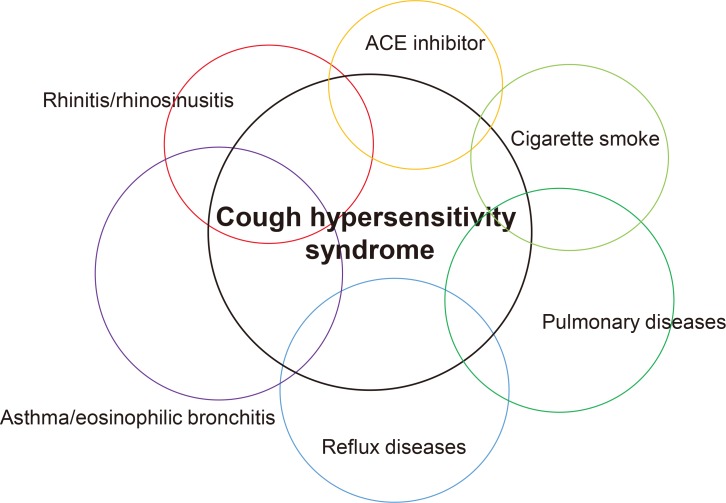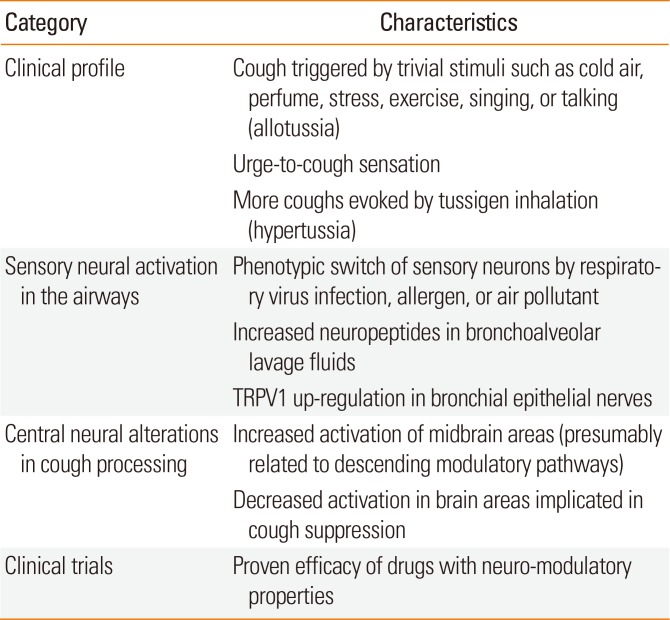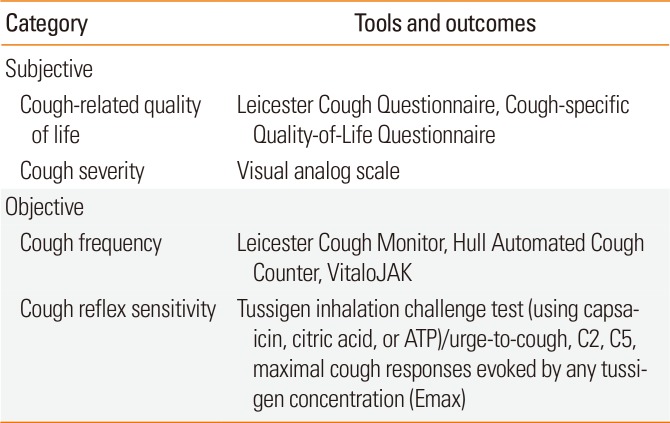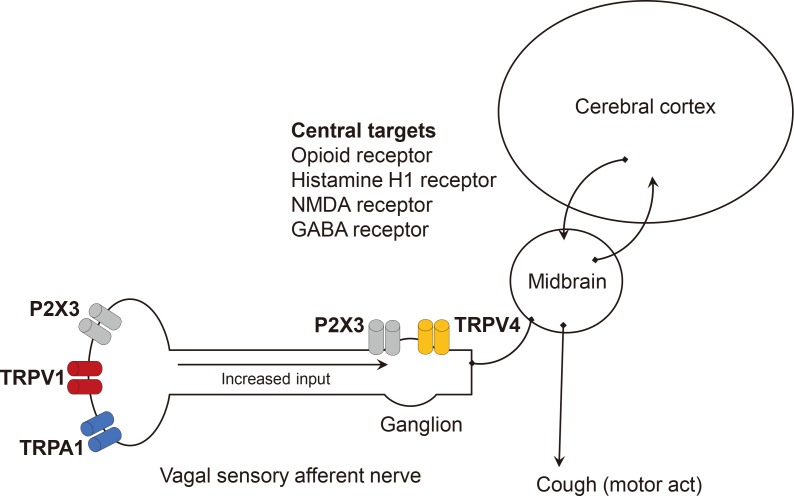2. Vertigan AE, Gibson PG. Chronic refractory cough as a sensory neuropathy: evidence from a reinterpretation of cough triggers. J Voice. 2011; 25:596–601. PMID:
21051202.

3. Matsumoto H, Tabuena RP, Niimi A, Inoue H, Ito I, Yamaguchi M, et al. Cough triggers and their pathophysiology in patients with prolonged or chronic cough. Allergol Int. 2012; 61:123–132. PMID:
22377525.

4. Song WJ, Kim JY, Jo EJ, Lee SE, Kim MH, Yang MS, et al. Capsaicin cough sensitivity is related to the older female predominant feature in chronic cough patients. Allergy Asthma Immunol Res. 2014; 6:401–408. PMID:
25228996.

5. Kanemitsu Y, Matsumoto H, Osman N, Oguma T, Nagasaki T, Izuhara Y, et al. “Cold air” and/or “talking” as cough triggers, a sign for the diagnosis of cough variant asthma. Respir Investig. 2016; 54:413–418.

6. Schappert SM. National Ambulatory Medical Care Survey: 1991 summary. Vital Health Stat 13. 1994; 1–110.
7. Cho SH, Lin HC, Ghoshal AG, Bin Abdul Muttalif AR, Thanaviratananich S, Bagga S, et al. Respiratory disease in the Asia-Pacific region: cough as a key symptom. Allergy Asthma Proc. 2016; 37:131–140. PMID:
26802834.

8. Yoo KH, Ahn HR, Park JK, Kim JW, Nam GH, Hong SK, et al. Burden of respiratory disease in Korea: an observational study on allergic rhinitis, asthma, COPD, and rhinosinusitis. Allergy Asthma Immunol Res. 2016; 8:527–534. PMID:
27582404.

9. Song WJ, Chang YS, Faruqi S, Kim JY, Kang MG, Kim S, et al. The global epidemiology of chronic cough in adults: a systematic review and meta-analysis. Eur Respir J. 2015; 45:1479–1481. PMID:
25657027.

10. Kang MG, Song WJ, Kim HJ, Won HK, Sohn KH, Kang SY, et al. Point prevalence and epidemiological characteristics of chronic cough in the general adult population: the Korean National Health and Nutrition Examination Survey 2010–2012. Medicine (Baltimore). 2017; 96:e6486. PMID:
28353590.
11. French CL, Irwin RS, Curley FJ, Krikorian CJ. Impact of chronic cough on quality of life. Arch Intern Med. 1998; 158:1657–1661. PMID:
9701100.

12. Birring SS, Prudon B, Carr AJ, Singh SJ, Morgan MD, Pavord ID. Development of a symptom specific health status measure for patients with chronic cough: Leicester Cough Questionnaire (LCQ). Thorax. 2003; 58:339–343. PMID:
12668799.

13. Song WJ, Morice AH, Kim MH, Lee SE, Jo EJ, Lee SM, et al. Cough in the elderly population: relationships with multiple comorbidity. PLoS One. 2013; 8:e78081. PMID:
24205100.

14. Morice AH. Epidemiology of cough. Pulm Pharmacol Ther. 2002; 15:253–259. PMID:
12099774.

15. Morice AH. Over-the-counter cough medicines: new approaches. Pulm Pharmacol Ther. 2015; 35:149–151. PMID:
26232720.

16. McGarvey LP. Idiopathic chronic cough: a real disease or a failure of diagnosis? Cough. 2005; 1:9. PMID:
16270939.

17. Dicpinigaitis PV. Cough: an unmet clinical need. Br J Pharmacol. 2011; 163:116–124. PMID:
21198555.

18. Chamberlain SA, Garrod R, Douiri A, Masefield S, Powell P, Bücher C, et al. The impact of chronic cough: a cross-sectional European survey. Lung. 2015; 193:401–408. PMID:
25787221.

19. Birring SS, Spinou A. How best to measure cough clinically. Curr Opin Pharmacol. 2015; 22:37–40. PMID:
25819594.

20. Gibson PG. Atopic cough. Thorax. 2004; 59:449.
21. O'Hara J, Jones NS. “Post-nasal drip syndrome”: most patients with purulent nasal secretions do not complain of chronic cough. Rhinology. 2006; 44:270–273. PMID:
17216744.
22. Hom C, Vaezi MF. Extraesophageal manifestations of gastroesophageal reflux disease. Gastroenterol Clin North Am. 2013; 42:71–91. PMID:
23452632.

23. Morice AH. The cough hypersensitivity syndrome: a novel paradigm for understanding cough. Lung. 2010; 188(Suppl 1):S87–S90. PMID:
19809853.

24. Chung KF. Chronic ‘cough hypersensitivity syndrome’: a more precise label for chronic cough. Pulm Pharmacol Ther. 2011; 24:267–271. PMID:
21292019.

25. Canning BJ, Chang AB, Bolser DC, Smith JA, Mazzone SB, McGarvey L, et al. Anatomy and neurophysiology of cough: CHEST Guideline and Expert Panel report. Chest. 2014; 146:1633–1648. PMID:
25188530.
26. Song WJ, Chang YS, Morice AH. Changing the paradigm for cough: does ‘cough hypersensitivity’ aid our understanding? Asia Pac Allergy. 2014; 4:3–13. PMID:
24527404.

27. Morice AH, Millqvist E, Belvisi MG, Bieksiene K, Birring SS, Chung KF, et al. Expert opinion on the cough hypersensitivity syndrome in respiratory medicine. Eur Respir J. 2014; 44:1132–1148. PMID:
25142479.

28. Chung KF, McGarvey L, Mazzone SB. Chronic cough as a neuropathic disorder. Lancet Respir Med. 2013; 1:414–422. PMID:
24429206.

29. Niimi A, Chung KF. Evidence for neuropathic processes in chronic cough. Pulm Pharmacol Ther. 2015; 35:100–104. PMID:
26474678.

30. Driessen AK, McGovern AE, Narula M, Yang SK, Keller JA, Farrell MJ, et al. Central mechanisms of airway sensation and cough hypersensitivity. Pulm Pharmacol Ther. 2017; Forthcoming.
31. Hilton E, Marsden P, Thurston A, Kennedy S, Decalmer S, Smith JA. Clinical features of the urge-to-cough in patients with chronic cough. Respir Med. 2015; 109:701–707. PMID:
25892291.

32. Sinha A, Lee KK, Rafferty GF, Yousaf N, Pavord ID, Galloway J, et al. Predictors of objective cough frequency in pulmonary sarcoidosis. Eur Respir J. 2016; 47:1461–1471. PMID:
26846840.

33. Morice AH, Lowry R, Brown MJ, Higenbottam T. Angiotensin-converting enzyme and the cough reflex. Lancet. 1987; 2:1116–1118. PMID:
2890021.

34. Prudon B, Birring SS, Vara DD, Hall AP, Thompson JP, Pavord ID. Cough and glottic-stop reflex sensitivity in health and disease. Chest. 2005; 127:550–557. PMID:
15705995.

35. Ando A, Smallwood D, McMahon M, Irving L, Mazzone SB, Farrell MJ. Neural correlates of cough hypersensitivity in humans: evidence for central sensitisation and dysfunctional inhibitory control. Thorax. 2016; 71:323–329. PMID:
26860344.

36. O'Connell F, Thomas VE, Pride NB, Fuller RW. Capsaicin cough sensitivity decreases with successful treatment of chronic cough. Am J Respir Crit Care Med. 1994; 150:374–380. PMID:
8049818.
37. Othumpangat S, Gibson LF, Samsell L, Piedimonte G. NGF is an essential survival factor for bronchial epithelial cells during respiratory syncytial virus infection. PLoS One. 2009; 4:e6444. PMID:
19649262.

38. Omar S, Clarke R, Abdullah H, Brady C, Corry J, Winter H, et al. Respiratory virus infection up-regulates TRPV1, TRPA1 and ASICS3 receptors on airway cells. PLoS One. 2017; 12:e0171681. PMID:
28187208.

39. Abdullah H, Heaney LG, Cosby SL, McGarvey LP. Rhinovirus upregulates transient receptor potential channels in a human neuronal cell line: implications for respiratory virus-induced cough reflex sensitivity. Thorax. 2014; 69:46–54. PMID:
24002057.

40. Zaccone EJ, Lieu T, Muroi Y, Potenzieri C, Undem BE, Gao P, et al. Parainfluenza 3-induced cough hypersensitivity in the guinea pig airways. PLoS One. 2016; 11:e0155526. PMID:
27213574.

41. Undem BJ, Taylor-Clark T. Mechanisms underlying the neuronal-based symptoms of allergy. J Allergy Clin Immunol. 2014; 133:1521–1534. PMID:
24433703.

42. Lv H, Yue J, Chen Z, Chai S, Cao X, Zhan J, et al. Effect of transient receptor potential vanilloid-1 on cough hypersensitivity induced by particulate matter 2.5. Life Sci. 2016; 151:157–166. PMID:
26926080.

43. McCormack DG, Mak JC, Coupe MO, Barnes PJ. Calcitonin gene-related peptide vasodilation of human pulmonary vessels. J Appl Physiol (1985). 1989; 67:1265–1270. PMID:
2551879.

44. Numao T, Agrawal DK. Neuropeptides modulate human eosinophil chemotaxis. J Immunol. 1992; 149:3309–3315. PMID:
1385521.
45. Mikami N, Matsushita H, Kato T, Kawasaki R, Sawazaki T, Kishimoto T, et al. Calcitonin gene-related peptide is an important regulator of cutaneous immunity: effect on dendritic cell and T cell functions. J Immunol. 2011; 186:6886–6893. PMID:
21551361.

46. Song WJ, Chang YS. Cough hypersensitivity as a neuro-immune interaction. Clin Transl Allergy. 2015; 5:24. PMID:
26180629.

47. McGarvey LP, Forsythe P, Heaney LG, MacMahon J, Ennis M. Bronchoalveolar lavage findings in patients with chronic nonproductive cough. Eur Respir J. 1999; 13:59–65. PMID:
10836324.

48. Forsythe P, McGarvey LP, Heaney LG, MacMahon J, Ennis M. Sensory neuropeptides induce histamine release from bronchoalveolar lavage cells in both nonasthmatic coughers and cough variant asthmatics. Clin Exp Allergy. 2000; 30:225–232. PMID:
10651775.

49. Chaudhuri R, McMahon AD, Thomson LJ, MacLeod KJ, McSharry CP, Livingston E, et al. Effect of inhaled corticosteroids on symptom severity and sputum mediator levels in chronic persistent cough. J Allergy Clin Immunol. 2004; 113:1063–1070. PMID:
15208586.

50. Birring SS, Parker D, Brightling CE, Bradding P, Wardlaw AJ, Pavord ID. Induced sputum inflammatory mediator concentrations in chronic cough. Am J Respir Crit Care Med. 2004; 169:15–19. PMID:
14512269.

51. O'Connell F, Springall DR, Moradoghli-Haftvani A, Krausz T, Price D, Fuller RW, et al. Abnormal intraepithelial airway nerves in persistent unexplained cough? Am J Respir Crit Care Med. 1995; 152:2068–2075. PMID:
8520777.
52. Groneberg DA, Niimi A, Dinh QT, Cosio B, Hew M, Fischer A, et al. Increased expression of transient receptor potential vanilloid-1 in airway nerves of chronic cough. Am J Respir Crit Care Med. 2004; 170:1276–1280. PMID:
15447941.

53. Mitchell JE, Campbell AP, New NE, Sadofsky LR, Kastelik JA, Mulrennan SA, et al. Expression and characterization of the intracellular vanilloid receptor (TRPV1) in bronchi from patients with chronic cough. Exp Lung Res. 2005; 31:295–306. PMID:
15962710.

54. West PW, Canning BJ, Merlo-Pich E, Woodcock AA, Smith JA. Morphologic characterization of nerves in whole-mount airway biopsies. Am J Respir Crit Care Med. 2015; 192:30–39. PMID:
25906337.

55. Lau BK, Vaughan CW. Descending modulation of pain: the GABA disinhibition hypothesis of analgesia. Curr Opin Neurobiol. 2014; 29:159–164. PMID:
25064178.

56. Mazzone SB, Cole LJ, Ando A, Egan GF, Farrell MJ. Investigation of the neural control of cough and cough suppression in humans using functional brain imaging. J Neurosci. 2011; 31:2948–2958. PMID:
21414916.

57. Hilton EC, Baverel PG, Woodcock A, Van Der Graaf PH, Smith JA. Pharmacodynamic modeling of cough responses to capsaicin inhalation calls into question the utility of the C5 end point. J Allergy Clin Immunol. 2013; 132:847–855.e5. PMID:
23777849.

58. Morice AH, Menon MS, Mulrennan SA, Everett CF, Wright C, Jackson J, et al. Opiate therapy in chronic cough. Am J Respir Crit Care Med. 2007; 175:312–315. PMID:
17122382.

59. Birring SS, Brew J, Kilbourn A, Edwards V, Wilson R, Morice AH. Rococo study: a real-world evaluation of an over-the-counter medicine in acute cough (a multicentre, randomised, controlled study). BMJ Open. 2017; 7:e014112.

60. Dickinson RS, Morjaria JB, Wright CE, Morice AH. Is opiate action in cough due to sedation? Ther Adv Chronic Dis. 2014; 5:200–205. PMID:
25177477.

61. Chen CY, Bonham AC, Schelegle ES, Gershwin LJ, Plopper CG, Joad JP. Extended allergen exposure in asthmatic monkeys induces neuroplasticity in nucleus tractus solitarius. J Allergy Clin Immunol. 2001; 108:557–562. PMID:
11590381.

62. Spaziano G, Luongo L, Guida F, Petrosino S, Matteis M, Palazzo E, et al. Exposure to allergen causes changes in nts neural activities after intratracheal capsaicin application, in endocannabinoid levels and in the glia morphology of NTS. Biomed Res Int. 2015; 2015:980983. PMID:
25866824.

63. Sekizawa S, Chen CY, Bechtold AG, Tabor JM, Bric JM, Pinkerton KE, et al. Extended secondhand tobacco smoke exposure induces plasticity in nucleus tractus solitarius second-order lung afferent neurons in young guinea pigs. Eur J Neurosci. 2008; 28:771–781. PMID:
18657181.

64. Ryan NM, Birring SS, Gibson PG. Gabapentin for refractory chronic cough: a randomised, double-blind, placebo-controlled trial. Lancet. 2012; 380:1583–1589. PMID:
22951084.

65. Vertigan AE, Kapela SL, Ryan NM, Birring SS, McElduff P, Gibson PG. Pregabalin and speech pathology combination therapy for refractory chronic cough: a randomized controlled trial. Chest. 2016; 149:639–648. PMID:
26447687.
66. Abdulqawi R, Dockry R, Holt K, Layton G, McCarthy BG, Ford AP, et al. P2X3 receptor antagonist (AF-219) in refractory chronic cough: a randomised, double-blind, placebo-controlled phase 2 study. Lancet. 2015; 385:1198–1205. PMID:
25467586.

67. Chamberlain Mitchell SA, Garrod R, Clark L, Douiri A, Parker SM, Ellis J, et al. Physiotherapy, and speech and language therapy intervention for patients with refractory chronic cough: a multicentre randomised control trial. Thorax. 2017; 72:129–136. PMID:
27682331.

68. Morice AH, Fontana GA, Belvisi MG, Birring SS, Chung KF, Dicpinigaitis PV, et al. ERS guidelines on the assessment of cough. Eur Respir J. 2007; 29:1256–1276. PMID:
17540788.

69. Morice AH, Geppetti P. Cough. 5: the type 1 vanilloid receptor: a sensory receptor for cough. Thorax. 2004; 59:257–258. PMID:
14985566.
70. Khalid S, Murdoch R, Newlands A, Smart K, Kelsall A, Holt K, et al. Transient receptor potential vanilloid 1 (TRPV1) antagonism in patients with refractory chronic cough: a double-blind randomized controlled trial. J Allergy Clin Immunol. 2014; 134:56–62. PMID:
24666696.
71. Birrell MA, Belvisi MG, Grace M, Sadofsky L, Faruqi S, Hele DJ, et al. TRPA1 agonists evoke coughing in guinea pig and human volunteers. Am J Respir Crit Care Med. 2009; 180:1042–1047. PMID:
19729665.

72. Burnstock G, Brouns I, Adriaensen D, Timmermans JP. Purinergic signaling in the airways. Pharmacol Rev. 2012; 64:834–868. PMID:
22885703.

73. Fowles HE, Rowland T, Wright C, Morice A. Tussive challenge with ATP and AMP: does it reveal cough hypersensitivity? Eur Respir J. 2017; 49:1601452. PMID:
28179439.

74. Bonvini SJ, Birrell MA, Grace MS, Maher SA, Adcock JJ, Wortley MA, et al. Transient receptor potential cation channel, subfamily V, member 4 and airway sensory afferent activation: Role of adenosine triphosphate. J Allergy Clin Immunol. 2016; 138:249–261.e12. PMID:
26792207.

75. Turner RD, Bothamley GH. Cough hypersensitivity syndrome: clinical measurement is the key to progress. Eur Respir J. 2015; 45:1507–1508. PMID:
25931491.

76. Morice AH, Millqvist E, Belvisi MG, Bieksiene K, Birring SS, Chung KF, et al. Cough hypersensitivity syndrome: clinical measurement is the key to progress. Eur Respir J. 2015; 45:1509–1510. PMID:
25931492.

77. Yousaf N, Monteiro W, Matos S, Birring SS, Pavord ID. Cough frequency in health and disease. Eur Respir J. 2013; 41:241–243. PMID:
23277523.

78. Song WJ, Chang YS, Faruqi S, Kang MK, Kim JY, Kang MG, et al. Defining chronic cough: a systematic review of the epidemiological literature. Allergy Asthma Immunol Res. 2016; 8:146–155. PMID:
26739408.

79. Morice AH, Jakes AD, Faruqi S, Birring SS, McGarvey L, Canning B, et al. A worldwide survey of chronic cough: a manifestation of enhanced somatosensory response. Eur Respir J. 2014; 44:1149–1155. PMID:
25186267.

80. Pisinger C, Godtfredsen NS, Jørgensen T. Smoking reduction and cessation reduce chronic cough in a general population: the Inter99 study. Clin Respir J. 2008; 2:41–46. PMID:
20298303.

81. French CT, Irwin RS, Fletcher KE, Adams TM. Evaluation of a cough-specific quality-of-life questionnaire. Chest. 2002; 121:1123–1131. PMID:
11948042.

82. Kwon JW, Moon JY, Kim SH, Song WJ, Kim MH, Kang MG, et al. Reliability and validity of a Korean version of the leicester cough questionnaire. Allergy Asthma Immunol Res. 2015; 7:230–233. PMID:
25749761.

83. Faruqi S, Thompson R, Wright C, Sheedy W, Morice AH. Quantifying chronic cough: objective versus subjective measurements. Respirology. 2011; 16:314–320. PMID:
21054670.

84. Agusti A, Bel E, Thomas M, Vogelmeier C, Brusselle G, Holgate S, et al. Treatable traits: toward precision medicine of chronic airway diseases. Eur Respir J. 2016; 47:410–419. PMID:
26828055.

85. Song WJ, Kwon JW, Kim EJ, Lee SM, Kim SH, Lee SY, et al. Clinical application of exhaled nitric oxide measurements in a Korean population. Allergy Asthma Immunol Res. 2015; 7:3–13. PMID:
25553257.

86. Song WJ, Kim HJ, Shim JS, Won HK, Kang SY, Sohn KH, et al. Diagnostic accuracy of fractional exhaled nitric oxide measurement in predicting cough-variant asthma and eosinophilic bronchitis in adults with chronic cough: a systematic review and meta-analysis. J Allergy Clin Immunol. 2017; Forthcoming.
87. Marsden PA, Satia I, Ibrahim B, Woodcock A, Yates L, Donnelly I, et al. Objective cough frequency, airway inflammation, and disease control in asthma. Chest. 2016; 149:1460–1466. PMID:
26973014.

88. Natarajan S, Free RC, Bradding P, McGarvey L, Siddiqui S. The relationship between the Leicester cough questionnaire, eosinophilic airway inflammation and asthma patient related outcomes in severe adult asthma. Respir Res. 2017; 18:44. PMID:
28259163.

89. Satia I, Tsamandouras N, Holt K, Badri H, Woodhead M, Ogungbenro K, et al. Capsaicin-evoked cough responses in asthmatic patients: evidence for airway neuronal dysfunction. J Allergy Clin Immunol. 2017; 139:771–779.e10. PMID:
27444176.

90. Nathan RA, Sorkness CA, Kosinski M, Schatz M, Li JT, Marcus P, et al. Development of the asthma control test: a survey for assessing asthma control. J Allergy Clin Immunol. 2004; 113:59–65. PMID:
14713908.
91. Juniper EF, O'Byrne PM, Guyatt GH, Ferrie PJ, King DR. Development and validation of a questionnaire to measure asthma control. Eur Respir J. 1999; 14:902–907. PMID:
10573240.

92. Guan WJ, Gao YH, Xu G, Lin ZY, Tang Y, Li HM, et al. Capsaicin cough sensitivity and the association with clinical parameters in bronchiectasis. PLoS One. 2014; 9:e113057. PMID:
25409316.

93. van Manen MJ, Birring SS, Vancheri C, Cottin V, Renzoni EA, Russell AM, et al. Cough in idiopathic pulmonary fibrosis. Eur Respir Rev. 2016; 25:278–286. PMID:
27581827.








 PDF
PDF ePub
ePub Citation
Citation Print
Print



 XML Download
XML Download